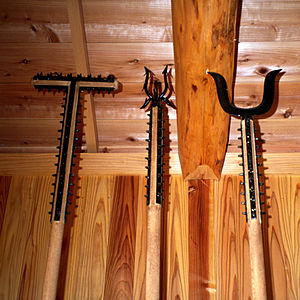- Sasumata
-
The sasumata (刺股) is a Japanese mancatcher and firefighting tool. Historically, it was usually around 2 meters in length, with a U-shaped head. This head looks similar to a koto bridge, so it is sometimes called a kotojibō. The pole is often sturdy wood, reinforced with iron. Small spikes or other sharp protrusions can often be found along the pole, similar to the tsukubō and sodegarami. Together with those other implements it is part of the torimono sandōgu used for both firefighting and by police.
Today, a modern version of the sasumata is still occasionally used by the police and as a self-defense tool. These modern sasumata are often made of aluminum, without the sharpened blades and spikes found on their medieval counterparts. They have been marketed to schools due to a growing fear of classroom invasions, according to Japanese newspapers such as the Mainichi Shinbun.
 Weapons for capturing thieves: on the left tsukubō, in the middle sodegarami and on the right sasumata
Weapons for capturing thieves: on the left tsukubō, in the middle sodegarami and on the right sasumata
Contents
History
Although some sources place the origin of the sasumata in the Muromachi period, most sources discuss its use in the Edo period. Don Cunningham claims that the firefighting version of the implement was also known as a chokyakusan, rinkaku, tetsubashira, and tokikama. He goes on to mention that there was a similar weapon in China known as a chang jiao qian, and sometimes called a cha gan or huo cha (fire fork), which may have had a similar firefighting role. The sasumata was used by firefighters to help disassemble burning buildings, raise ladders, and otherwise assist with their duties.
Law enforcement in Edo used the sasumata along with the sodegarami (sleeve catcher) and tsukubō (thrusting pole) as the torimono sandōgu to restrain and arrest criminals. The head of the sasumata would be used to catch around the neck, arms, legs, or joints of a suspect and detain them until officers could close in and tie them up (using hojōjutsu). Spikes and barbs would be affixed to prevent criminals from grasping the pole and wresting the weapon from the police officers. These could also be used to help catch sleeves and clothing, similar to the sodegarami. The opposite end of the weapon would often have a metal cap, or ishizuki like those found on naginata and other pole weapons.
Today, the sasumata is marketed as a tool for law enforcement as well as schools. A reported rise in school invasions has prompted some schools in Japan to keep sasumata available as a method for teachers to protect themselves or students and detain a potential threat until the authorities can arrive. (Mainichi Shinbun 2004).
See also
Gallery
References
- Cunningham, Don. Taiho-jutsu:Law and Order in the Age of the Samurai. Boston; Rutland, Vermont; Tokyo: Tuttle Publishing, 2004.
- 神之田常盛. 剣術神道霞流. 萩原印刷株式会社, 2003.
- Mol, Serge. Classic Weaponry of Japan: Special Weapons and Tactics of the Martial Arts. Tokyo; New York; London: Kodansha International, 2003.
Categories:- Police weapons
- Weapons of Japan
- Pole weapons
- Samurai weapons and equipment
Wikimedia Foundation. 2010.



